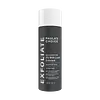Trinny London Find Your Balance BHA Toner Versus Paula's Choice Skin Perfecting 2% BHA Liquid Exfoliant
What's inside
What's inside
 Key Ingredients
Key Ingredients

 Benefits
Benefits

 Concerns
Concerns

 Ingredients Side-by-side
Ingredients Side-by-side

Water
Skin ConditioningPentylene Glycol
Skin ConditioningSodium Lactate
BufferingGlycerin
HumectantMethylpropanediol
SolventSalix Nigra Bark Extract
Skin ProtectingMandelic Acid
AntimicrobialChlorella Vulgaris Extract
Skin ConditioningMalva Sylvestris Flower Extract
Skin ConditioningCinnamomum Cassia Bark
Skin ConditioningSanguisorba Officinalis Root Extract
CleansingZingiber Officinale Root Extract
MaskingUrtica Dioica Extract
AstringentXanthan Gum
EmulsifyingAcetum
Caprylyl Glycol
EmollientPropanediol
SolventSalicylic Acid
MaskingDextrin
AbsorbentPolydextrose
HumectantAmylopectin
Niacinamide
SmoothingPhenylpropanol
MaskingLactic Acid
BufferingPotassium Sorbate
PreservativeSodium Benzoate
MaskingWater, Pentylene Glycol, Sodium Lactate, Glycerin, Methylpropanediol, Salix Nigra Bark Extract, Mandelic Acid, Chlorella Vulgaris Extract, Malva Sylvestris Flower Extract, Cinnamomum Cassia Bark, Sanguisorba Officinalis Root Extract, Zingiber Officinale Root Extract, Urtica Dioica Extract, Xanthan Gum, Acetum, Caprylyl Glycol, Propanediol, Salicylic Acid, Dextrin, Polydextrose, Amylopectin, Niacinamide, Phenylpropanol, Lactic Acid, Potassium Sorbate, Sodium Benzoate
 Reviews
Reviews

Ingredients Explained
These ingredients are found in both products.
Ingredients higher up in an ingredient list are typically present in a larger amount.
Methylpropanediol is a synthetic solvent and humectant.
As a solvent, it helps dissolve other ingredients, helping to evenly distribute ingredients throughout the product. This ingredient has also been shown to have antimicrobial properties which makes it a preservative booster.
Methylpropanediol is able to add a bit of moisture to the skin. It also helps other ingredients be better absorbed into the skin, such as salicylic acid.
Learn more about MethylpropanediolSalicylic Acid (also known as beta hydroxy acid or BHA) is a well-known ingredient for treating skin that struggles with acne and clogged pores. It exfoliates both the skin's surface and deep within the pores to help clear out buildup, control oil, and reduce inflammation.
Unlike AHAs (alpha hydroxy acids), salicylic acid is oil-soluble. This allows it to penetrate into pores which makes it especially effective for treating blackheads and preventing future breakouts.
Salicylic acid is also known for its soothing properties. It has a similar structure to aspirin and can calm inflamed or irritated skin, making it a good option for acne-prone skin that is also sensitive.
Concentrations of 0.5-2% are recognized by the U.S. FDA as an over-the-counter topical acne product.
It can cause irritation and/or dryness if one's skin already has a compromised moisture barrier, so it's best to focus on repairing that before introducing this ingredient into your routine.
While salicylic acid does not increase sun sensitivity, it’s still important to wear sunscreen daily to protect your skin.
If you are looking for the ingredient called BHA or Butylated Hydroxyanisole, click here.
Learn more about Salicylic AcidWater. It's the most common cosmetic ingredient of all. You'll usually see it at the top of ingredient lists, meaning that it makes up the largest part of the product.
So why is it so popular? Water most often acts as a solvent - this means that it helps dissolve other ingredients into the formulation.
You'll also recognize water as that liquid we all need to stay alive. If you see this, drink a glass of water. Stay hydrated!
Learn more about Water